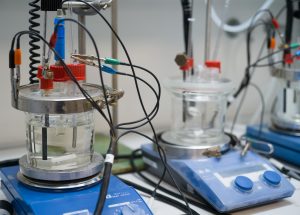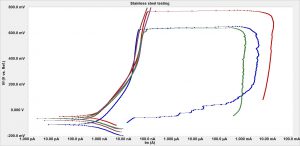 In the laboratories of METALogic cyclic polarization measurements are performed to study the behaviour of metals under different exposure conditions: measuring a corrosion rate, resistance to pitting corrosion, passivation behaviour and others. After measurement of the open circuit potential an increasing potential is applied to the metal followed by a decrease of the potential. During this process the current response is measured, resulting in a cyclic polarization curve based on which different parameters like open circuit potential, uniform corrosion rate, passivation potential, passivation current, pitting potential, repassivation potential, … can be determined.
In the laboratories of METALogic cyclic polarization measurements are performed to study the behaviour of metals under different exposure conditions: measuring a corrosion rate, resistance to pitting corrosion, passivation behaviour and others. After measurement of the open circuit potential an increasing potential is applied to the metal followed by a decrease of the potential. During this process the current response is measured, resulting in a cyclic polarization curve based on which different parameters like open circuit potential, uniform corrosion rate, passivation potential, passivation current, pitting potential, repassivation potential, … can be determined.
Within one day an estimation of the uniform corrosion rate and a risk for pitting corrosion can be established. Cyclic polarization measurements can be complementary to exposure tests since they can provide additional information.
 Polarization measurements can be performed based on following standards:
Polarization measurements can be performed based on following standards:
- ASTM G5: Standard Reference Test Method for Making Potentiostatic and Potentiodynamic Anodic Polarization Measurements
- ASTM G59: Standard Test Method for Conducting Potentiodynamic Polarization Resistance Measurements
- ASTM G61: Standard Test Method for Conducting Cyclic Potentiodynamic Polarization Measurements for Localized Corrosion Susceptibility of Iron-, Nickel-, or Cobalt-Based Alloys






